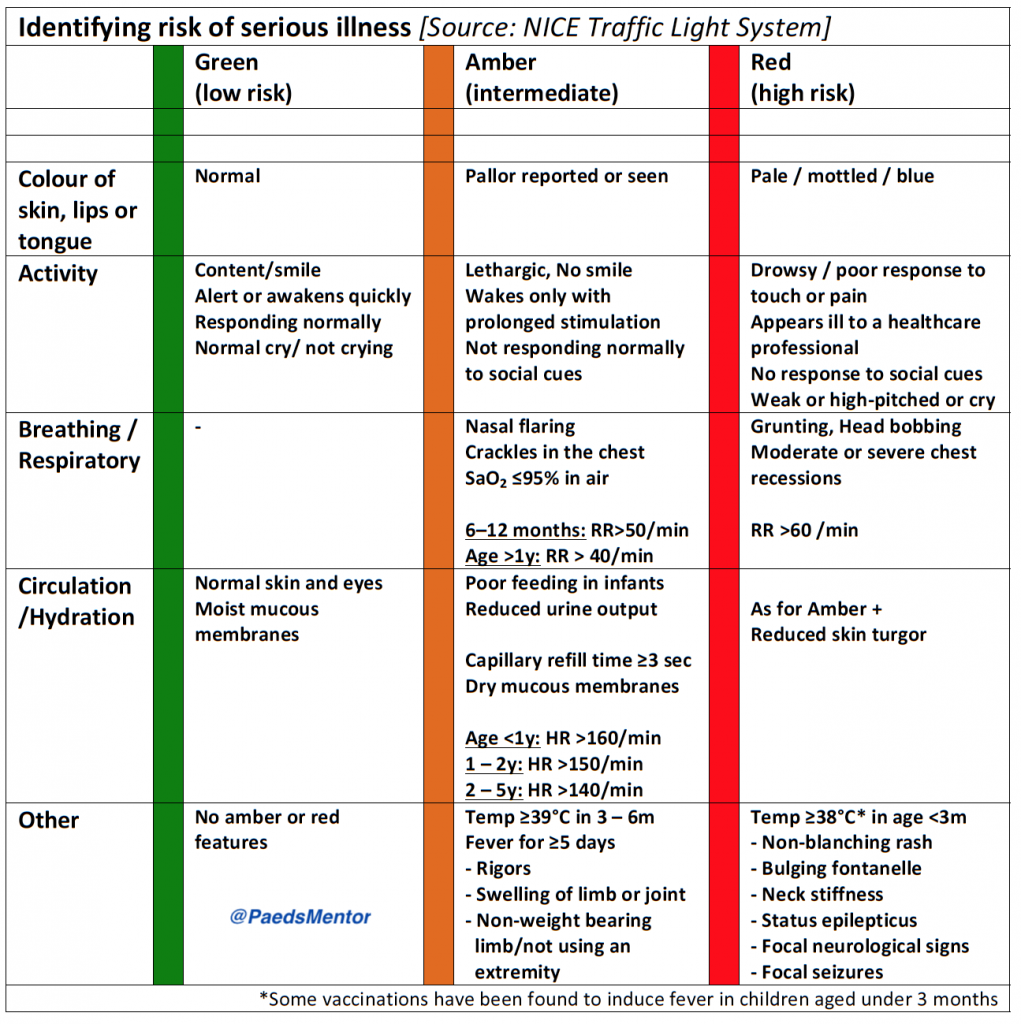Fever in a young child
Fever is a frequent reason for paediatric presentations, especially in young children, and often indicates an infectious cause. While most cases are due to self-limiting viral illnesses, a systematic approach is essential to identify and manage serious bacterial infections (SBI) or sepsis.
Clinical Assessment
A thorough clinical assessment is paramount and should follow the structured ABCDE approach to identify any immediately life-threatening features. The NICE traffic light system is a key tool used in the UK to help stratify the risk of serious illness in a febrile child.
History
Fever characteristics: Enquire about the duration, pattern, and use of antipyretics.
Worrying symptoms: Specifically ask about lethargy, irritability, reduced feeding/fluid intake, and signs of dehydration.
Other symptoms: Look for systemic features like rash, vomiting, diarrhoea, or cough.
High-risk groups: Have a low threshold for concern in infants under 3 months with a temperature of >38°C, or those aged 3–6 months with a temperature of >39°C. Also, consider immunocompromised children or those with complex chronic illnesses.
Examination
Vital Signs: Record temperature, heart rate, respiratory rate, capillary refill time (CRT), and oxygen saturation (SaO2).
General: Assess the child’s colour and hydration status.
Systemic: Perform a full examination of all systems, including ENT, cardiovascular, respiratory, abdominal, and neurological systems. A bulging fontanelle or neck stiffness is a red flag for meningitis.
Any child with fever have triage / initial assessment to identify any immediately life threatening features with the standard ABCDE approach, including recording of Temp, HR, RR, CRT and SaO2 (Also BP if high HR or lethargy)
– Colour and hydration status
– ENT: any bulging TM or fluid collection behind TM or discharging ear; coryza; Tonsillar hypertrophy or pus spots
– Lymph nodes: localized?, Small or enlarged?, Fluctuant?, Is there generalized lymphadenopathy?
– Rash: blanching?, Localized or generalized?, Maculopapular or Vesicular?
– Anterior fontanelle: is it open?, Bulging or sunken?
– Spontaneous movement of all 4 limbs?, walking normally or limping?
– RS: Any crackles or wheeze?, Is there increased work of breathing?
– CVS: Any new murmur?
– PA: Any organomegaly?, Any other mass? See hernia sites
– CNS: Are pupils equal & reactive?, Any neck stiffness or meningism?, Any focal neurological abnormality? Seizures?

Investigations
Investigations are guided by the clinical assessment and the NICE traffic light system. A low threshold for investigation is needed for young children or those who appear unwell.
Bloods: A full septic screen should be considered in high-risk children, including a full blood count, C-reactive protein (CRP), and blood cultures.
Urine: A urine culture should be considered in all febrile children under 3 years of age, especially if there is no clear focus for the fever.
Lumbar Puncture (LP): An LP should be considered in infants under 3 months with suspected sepsis, after discussion with a senior paediatrician.
Have a low threshold to investigate young children, those who appear unwell or those without a clear focus for cause of fever.
– FBC, U&E, CRP, Blood culture
– Consider Blood Gas, Lactate, Blood Glucose if child appears unwell
– Consider Urine culture in all young children (esp <3y age)
– Consider Lumbar puncture in young children (<3months as per NICE) if no contraindication. LP in older children if suspecting meningitis / encephalitis
– Consider Chest x-ray if respiratory signs present
– Consider stool culture if diarrhoea present
Other tests to consider case-by-case: LFT, Monospot/ EBV serology, Nasal secretions for virology or pertussis, ESR, Blood film thick smear for malaria parasites, USS abdomen and pelvis to look for collection, ECHO to exclude endocarditis.
Management
Antipyretics: Paracetamol or ibuprofen can be used to manage fever in children who are unwell, lethargic, or distressed. The primary aim is to improve the child’s comfort, not just to lower the temperature. Antipyretics do not prevent febrile convulsions.
Admission: Consider admission if the child has any red or amber features on the NICE traffic light system. Also, admit if there is high parental or staff concern or if the child has no clear focus for their fever.
Antibiotics: Do not delay the administration of broad-spectrum antibiotics in a child with suspected sepsis or meningitis.
<3 months: Cefotaxime + amoxicillin to cover for Listeria.
>3 months: Ceftriaxone.
Herpes Encephalitis: If suspected, add IV aciclovir.
Discharge: Before discharge, ensure the child appears well, has a clear cause for the fever, and has no red or amber features. Provide clear, written safety netting advice for parents, including when to seek further medical attention.
